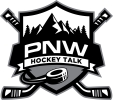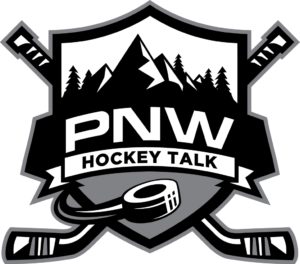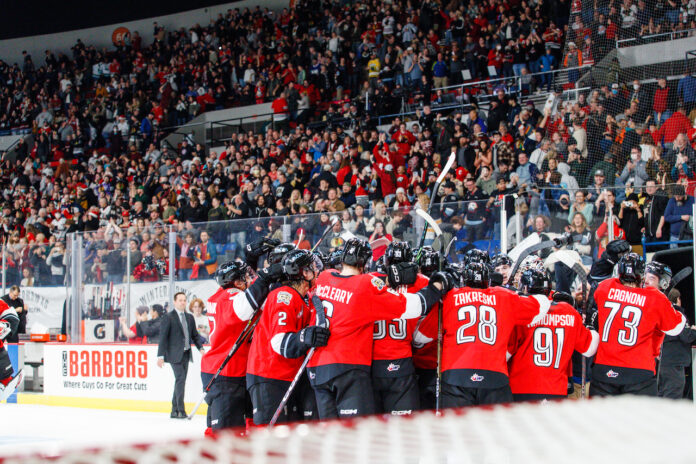
With the calendar flipping to 2023, the Western Hockey League trade deadline is fast approaching on January 10. The Portland Winterhawks currently sit second in the Western Conference – one point out of the top spot and eight points clear of third prior to games on January 4.
Being near the top of the standings is nothing new for the 47-year-old franchise, especially since the return of the current senior vice president, general manager, and head coach Mike Johnston in 2016.
What makes Portland unique in the league this season is its roster construction.
The Winterhawks are the only team who currently does not have a player who appeared in a game for another franchise.
All 23 members on the active roster have only played for Portland in their WHL careers.
The development work done by Johnston, associate coach Kyle Gustafson, assistant coach Brian Pellerin, director of scouting and assistant to the general manager Mike Coflin, and the rest of Portland’s hockey operations staff should be applauded.
This trend goes beyond the 2022-2023 season.
Over the past four years, only five players have been on Portland’s roster who also played in a game for another WHL franchise, and four of those are goaltenders.
The five are Taylor Gauthier during the 2021-2022 season following his trade from Prince George, Brock Gould played for the Winterhawks during the 24-game COVID season after playing with Victoria and Moose Jaw beforehand, and lastly, a trio of players from the 2019-2020 rounds out the list with Joel Hofer (Swift Current), Isaiah DiLaura (Prince George), and defenseman Christian Riemer (Swift Current) who appeared in two games.
“What this speaks to is our scouting staff and the phenomenal job they do of finding us players,” Johnston said. “If they didn’t find us good players we would have to go outside the organization, but they’ve continued to find the right types of players that fit how we want to play. I think it is exciting to have a homegrown team that we can say are all our guys.”
In addition to only having players who’ve appeared in a Portland jersey, Johnston built this year’s team with only two players who were selected in the top two rounds of the WHL Bantam Draft. Gabe Klassen was a first-round pick at 19th overall, while Buttazzoni got drafted in the second round.
Buttazzoni is the only player who was not drafted or listed by Portland originally. The 16-year-old forward was acquired in the offseason from the Medicine Hat Tigers before stepping onto the ice in the WHL.
Marek Alscher and Jan Špunar were first-round selections in the annual two-round CHL Import Draft.
18-year-old alternate captain Kyle Chyzowski is the lone third-round WHL Bantam Draft pick, 14 players were selected in rounds 4-11, and four were listed after not being selected following their 14-year-old season.
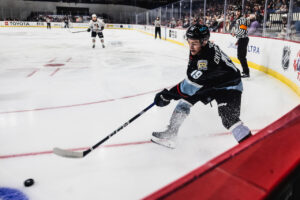
Three current Winterhawk defensemen were selected with a draft choice that originally did not belong to them (Credit to Alan Caldwell’s draft pick spreadsheet). Two of which came via trades Johnston made with Saskatoon Blades general manager Colin Priestner.
After being drafted by Portland, Carter Streek and the Winterhawks were not going to sign a Standard Player Agreement in 2020. Therefore, Johnston traded Streek’s rights one day prior to calling Carter Sotheran’s name in the 5th round. Sotheran was given a C-rating (projected 4th-, 5th-, and 6th round) from NHL Central Scouting.
Highly touted 16-year-old rookie defenseman Alex Thompson came courtesy of the Ryan Hughes trade nearly three years ago. Many remember Josh Paterson being the primary return piece; however, the fourth-round pick Saskatoon gave Portland was used on Thompson. (The Winterhawks also received a second-round pick, but Jayden Perron elected to go to the USHL instead).
Rhett Ravndahl rounds out this group, and the 6-foot-1 rear guard from Birch Hills, Saskatchewan, was selected with the pick Portland acquired when Nick Perna was traded to Medicine Hat.
“We are proud watching the players we’ve identified in drafting and our coaches and our staff have developed be successful,” Coflin said over the phone on Tuesday. “That is a point of pride for us. Seeing them have opportunities here means a lot to us. It is why our team of scouts are so passionate, why many of them have stayed with us for so long. It is because of the process as our scouts have input, and their time, energy, and talent evaluating people is appreciated by Mike (Johnston), and they are listened to and have a meaningful role with our team.”
Impacts of trading first and second-round draft picks away
Portland has needed to rely on these later-round finds following blockbuster trades in 2019 (Joel Hofer) and 2018 (Dennis Cholowski). The cost of acquiring high-end talent at the trade deadline is steep. Johnston moved a combined three first-round picks, three second-round selections, and six other pieces to make those moves.
Normally, when teams go “all-in,” the following years are lean and reflect a poor finish in the standings.
For the Winterhawks, in the three full seasons (excluding the 24-game COVID season) after trading away all the top-end draft choices, they finished first in the league in 2019-2020, tied for second in the Western Conference one point shy of the top spot in 2021-2022, and are in the same position so far in 2022-2023.
Johnston’s teams do not rebuild, they simply reload.
The absence of high draft picks makes Coflin’s job more challenging; however, it is one he’s both thrived and enjoyed.
“Our process in scouting is exactly the same each year because we might start a year without a top pick, and you never know if we are going to add a pick somewhere along the lines via a transaction. We are always prepared regardless if you are picking in the top of the draft or being ready in the middle rounds,” he said. “If you are picking near the top of the draft, while nothing is guaranteed, but the top 15 to 20 players on our list every year, those players truly have the chance to become elite players. You need elite players in order to compete. Any time a team gives up their ability to draft near the top, they are really reducing their odds of having the most talented players in the future.”
Johnston commented on his current approach, which somewhat changed a few years ago.
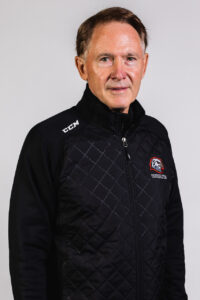
“During the COVID season, I told our scouts and coaches that I’m going to try as best I can to protect our first-round picks for the next three or four years. We had one last year and basically a first-rounder two years ago, it was the first pick of the second round. While, unfortunately, we missed on that Jayden Perron pick, we are starting to accumulate some first-round picks. I think it is important for me to protect those. If you look at the statistics, almost 70% of first-round picks turn out to be good, solid picks. When you go into the second, third, and fourth rounds, that percentage drops to below 50. We’ve been fortunate to hit recently, but that may not always be the case,” Johnston said.
As successful as Portland has been without its first-round picks, the counterargument is when the Winterhawks have selected in the first round, they find tremendous success. The five most recent first-round alumni are Seth Jarvis (2017), Cody Glass (2014), Nic Petan (2010), Derrick Pouliot (2009), and Ty Rattie (2008).
Identifying talent with mid-to-late-round picks
“A lot of our scouting staff has been with us for over ten years, and many of them have been scouts with us since I came in,” Johnston said. “We’ve added a few new scouts along the way, but we have continuity within our scouting department similar to our players. Some guys just fit exactly into our template. Other teams may not be as high on a guy as we are. On our list, he may be a third or fourth-round grade, but we are able to get him later because teams look for different types of players. When you look at some of our later-round guys, you immediately think, ‘Portland player, skates well, smart, and wasn’t overly big coming in his draft year.’ Fit is super important to us.”
Coflin credits the organization’s top brass for helping fuel the success in finding later-round gems.
“Drafting and scouting is a philosophical thing for us. Our ownership respects scouting. Even during the COVID years, when there were cutbacks across the league, our owners gave our scouts the ability to do their full job without compromise. That is a financial commitment from their point of view, and they saw value in what we do. This will end up protecting our 2006 and 2007 birth year classes,” he said. “Another thing we have in our favor here is we are aligned from our general manager to head coach to scouts. Mike Johnston is already invested in players’ success because he was involved in drafting and recruiting them.”
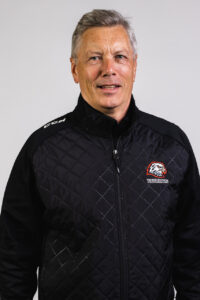
From Coflin’s point-of-view, what sets top picks apart from later-round picks is the moving away from the truly elite players. He mentioned as the draft progresses into the later rounds, many of those players still have “some qualities of excellence about them, just maybe not as many or as consistent as the top guys.”
One of Portland’s latest success stories in identifying top talent in the later rounds is 18-year-old forward Marcus Nguyen, who was drafted in the 11th round.
“As a 14-year-old (Nguyen) had high-end ability, but he had some other factors that teams shied away from,” Coflin shared. “We recognized the best of what a player like Marcus could be, and that’s why we drafted him. He responded and took becoming a complete player seriously. He dedicated himself to the game, and now he’s as consistent of a player as we have in our lineup. Those are the same things he was lacking three or four years ago, which held him back from where he was in the draft, but his pure talent was something he could do as well as anybody in the draft. You have to give the player all the credit because it is one thing for us to give him the opportunities and coaching, but they have to seize it. It is really cool when someone like Marcus does that and has success. Everyone involved is thrilled.”
From Nguyen’s perspective, he felt from the first day he joined the organization, he was put into positions where he could thrive.
“Speed is definitely a strength of my game, and that fits how Portland wants to play,” the Calgary native said. “I can complement my linemates by staying true to that. When I first got here at 16, I learned a couple of things about what it means to play in the WHL as a speed guy. I was able to learn from a guy like Seth Jarvis and how he used his speed not only offensively but on the defensive side as well.”
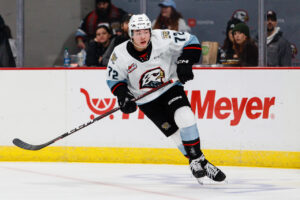
Nguyen is thankful for the chance Portland took on him in the draft and credited the Winterhawks culture for helping him take his game to the next level.
Despite being taken in the 11th round, Nguyen currently has the 21st most points in his draft class as of January 3.
“Looking back now, I’m still thankful for where I was drafted. It actually pushed me to work harder, compete, and fueled me to get better. One of the biggest things here in Portland is Mike pushing you to be the best player you can be but also a better person off the ice. Whether it is hockey after Portland or your post-hockey career, it is such a focal point here. I’m being treated equally and feel the same as everyone else regardless of where we were picked in the draft. Those are my brothers inside that room, and I love battling with them every day. I love going into games with those guys by my side. There is a great culture here, and these guys are going to be my friends forever. Doesn’t matter where you are drafted, it is about being a decent hockey player but, more important to be a decent human being. I’m thankful for being inside the Winterhawks organization,” Nguyen said.
Portland’s development model prioritizes patience
A roster does not consist of entirely homegrown talent without a strong emphasis on development from everyone involved.
“We as a hockey operations staff have to be patient with a player, but it is also up to the player as well to be patient with himself,” Johnston shared. “It could be really hard on a young player if they are traded the moment they aren’t immediately living up to expectations. That challenge also extends to a player if a coach is hard on them in terms of ice time if they make a mistake. Our approach has been to coach through the mistakes and ask guys what they are seeing. As they get older, they learn from the mistakes by being back out there again and not sitting on the bench thinking about what they did wrong.”
The development plan for a Winterhawks player is put together immediately following the draft or being listed. Johnston reiterated the importance of sticking with the established plan, “A 16-year-old could only have two goals, and many may want to give up on him. We say, ‘Let’s see how he responds at 17 because we can probably increase his goal total.’ Everyone is so focused on winning now. While that is important for us, we also want to win in the future as well, and that comes from developing guys and working with them through the highs and lows.”
A perfect example of the Winterhawks organization demonstrating patience with a player is former 7th-round pick, and overage forward, Robbie Fromm-Delorme, who currently leads the team in scoring.
“Mike and our coaches never walked away from Robbie at any point,” Coflin said. “Now, as an older player everyone is benefiting from that commitment. Robbie is now putting it all together with his maturity, and his readiness to be a top player, and fill a role on this team. His point totals and offensive side is now starting to reach his potential.”
Coflin pointed back to two previous Winterhawks captains in Nick Cicek and Johnny Ludvig. The team was again patient with them, and both players earned an NHL contract.
“What all these guys have in common is they are here with Portland for a full term of four or five years,” Coflin said.
“Being picked late in the draft was a benchmark for me, even though it was a little different for me because I had more of the college mindset. I remember when I was younger that there were a lot of teams I said no to if I would play for them if they drafted me. When I got a call from a family friend, and Portland scout, Brett Hopwo, I was asked if I wanted to play for Portland. I, of course, said yes. I’ve used my draft position as motivation throughout my career,” Fromm-Delorme said.
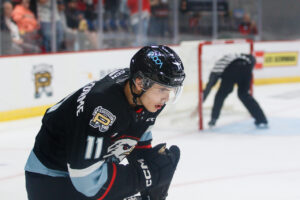
The 20-year-old from Richmond, British Columbia, shared how Portland’s development model worked for him.
“One thing I’ll say about Mike (Johnston) is that he’s amazing at getting everyone involved, not just the older guys. He wants the younger guys chipping in somehow, both on and off the ice. He wants to make sure we are developing everyone, whether it be learning from a leader or demonstrating leadership qualities. I was taught by older guys how to be a better player, and now I get to do the same for my younger teammates. Through patience with me, I’ve been able to find my role on this team and league. What’s made the difference for me is the coaches and me sticking with my development plan and me playing in a way that I could sustain, which wasn’t something I was doing when I was younger. There isn’t another team that handles development better than us.”
What Fromm-Delorme described is Portland’s culture. Coflin did not mind using that buzzword when talking about development.
“Our players are immersed in an atmosphere where they don’t really have a choice. They are going to go to school every day, work out hard every day, our practices are demanding, and they are going to be pushed hard and compete against each other,” he said. “If they are in Portland at 16 or 17, they are going to play. That judgment is made very carefully so that when they are here, they are full-time players who play a meaningful role and be prepared for success, especially in their draft years.”
Portland’s approach to development does not depend upon a player’s draft position.
Unlike many teams following the WHL Prospects Draft, Portland is not in a rush to sign its top picks.
“The benefit to our approach is that the whole draft class has to show us when they are ready,” Coflin said. “If the 8th round pick shows us they are ready first, then we recognize and reward that. If the 2nd round pick or one of the earlier picks is slower in that process, we will wait for them. We spend a lot of time as a scouting and coaching staff talking about, ‘Are they ready?’ ‘Can we envision them in our lineup?’ ‘What is the plan to get them there?’ If we can answer affirmatively to all of those questions, then they are a player we work aggressively to sign.”
List players can elevate a team
The Winterhawks currently have four listed players on its roster Jack O’Brien, James Stefan, Luca Cagnoni, and recently signed Braeden Jockims.
Players who were not selected in the WHL Prospects Draft are eligible to be added to the team’s 50-man protected list.
“Listing players just puts you over the top,” Johnston said. “You could be a middle-of-the-pack team, but your list players can put you into the top-team tier. This is especially true when you haven’t been able to stockpile first and second-round picks like we haven’t recently. When we had the suspensions those years, I talked with our scouts that we had to be the best listing team in the league, and that’s still true today. The listing process continues to be a way we’ve found success the last several years.”
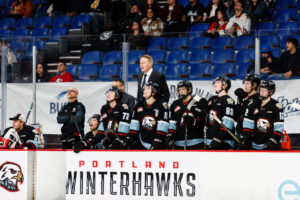
33 games into the season, three of the Winterhawks top five scorers were listed (Cagnoni, Stefan, and O’Brien).
Coflin knows that with drafting players at 14 years old there may be players who develop later.
“For a variety of reasons, sometimes it is physical maturity, sometimes situational, sometimes opportunity, sometimes it is their commitment to the game increasing, or their fitness level really being bought into, can lead to a delayed process for when you see the best from a player,” he said.
All of Portland’s scouts continue to watch players even after the draft year which has been a competitive advantage the last several seasons.
“You are going to find some players who are going to emerge later,” Coflin continued. “That is where I think our work ethic can pay off because we try to get to more games, and watch those age groups even more. When we do identify someone that is exciting, we try to have another scout watch them as well to get a second or even third set of eyes to see if that player could play for Portland one day. We don’t just immediately dismiss a player because they weren’t selected in the draft.”
Cagnoni, a B-rated prospect for the upcoming 2023 NHL Entry Draft, was not one of the 228 players, or 77 defensemen, selected in the 2019 WHL Bantam Draft.
However, Coflin and his scouting staff identified the raw talent and listed the Burnaby, British Columbia native.
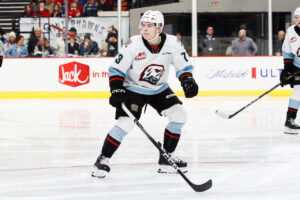
The development path for Cagnoni started with playing sparingly in the 24-game COVID season. His upward trajectory continued over the last two years to now, where he is quarterbacking the Winterhawks top power play.
“Development can happen in all different phases, and when those moments are going to happen, you don’t know,” Coflin said. “Early in the year last year, look at Cagnoni, who is an offensive defenseman who likes to take risks. He is a high-risk, high-reward guy for a reason. He is going to play through those mistakes, and now you don’t see as many of those turnovers and see better decisions and a more mature player who is playing with confidence and an understanding of the game. There is not really any magic to it, but you do need to live with sometimes a slower learning curve to get the result you want at the end. That is the patience our coaching staff has and a player who stuck with it.”
For a list player like O’Brien, his path to the Rose City looked different than his teammates.
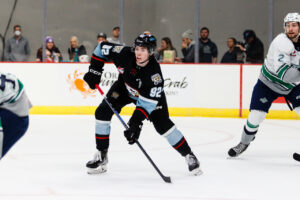
“How it happens is different for everyone, but for me, a scout came to one of my U15 games. As an American, it is always preached that you go to NCAA, and that is the only route you go. I didn’t really know much about the WHL or anything that went along with it. As I slowly learned more about the league, I thought about what was going to help me achieve my dreams of playing in the NHL, and there was zero doubt in my mind that Portland was the best place for me,” O’Brien said.
The now 19-year-old center from Denver, Colorado continued, “I came into this organization as an American who no one knew. I wasn’t this high draft pick that everyone was excited to watch. I didn’t have the clout or anything like that. I came in and knew that I needed to get to work, and that would be the only way I was going to get anywhere in my career or with this team. Portland is one of the closest junior organizations to a pro team. They run everything here like a pro team, and I couldn’t love that more. I trust what we are doing here and what this organization is doing to get me to the next level. I trust my development plan, all of my coaches, and the culture. The culture we have here is the same as you will find in the pros. Being here in Portland has helped me so much as I’m learning all the time, both on and off the ice. This place is really special.”
